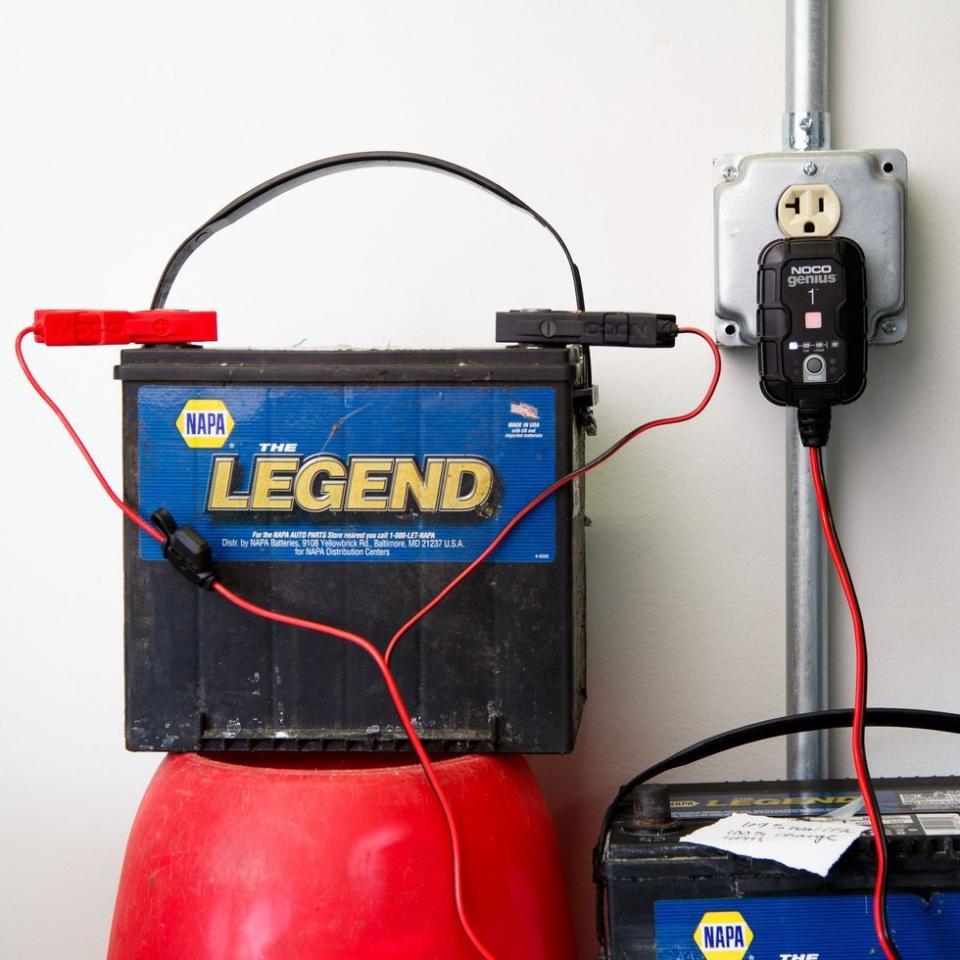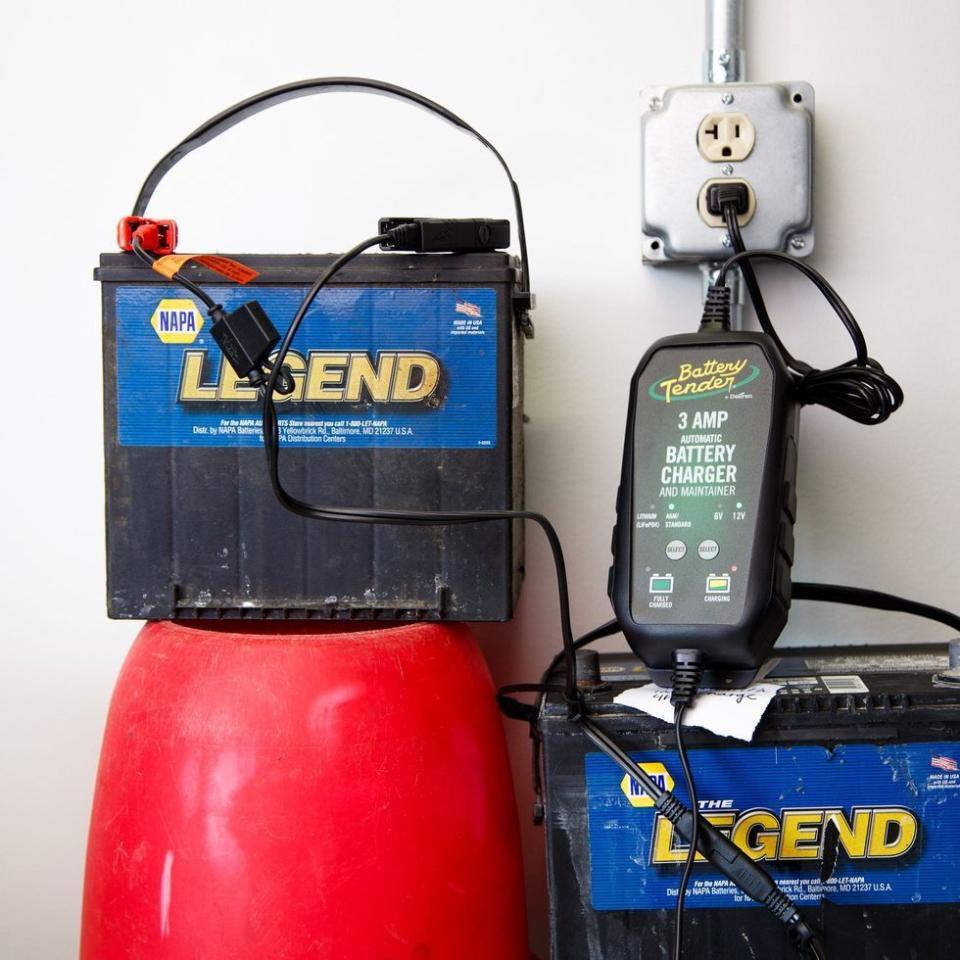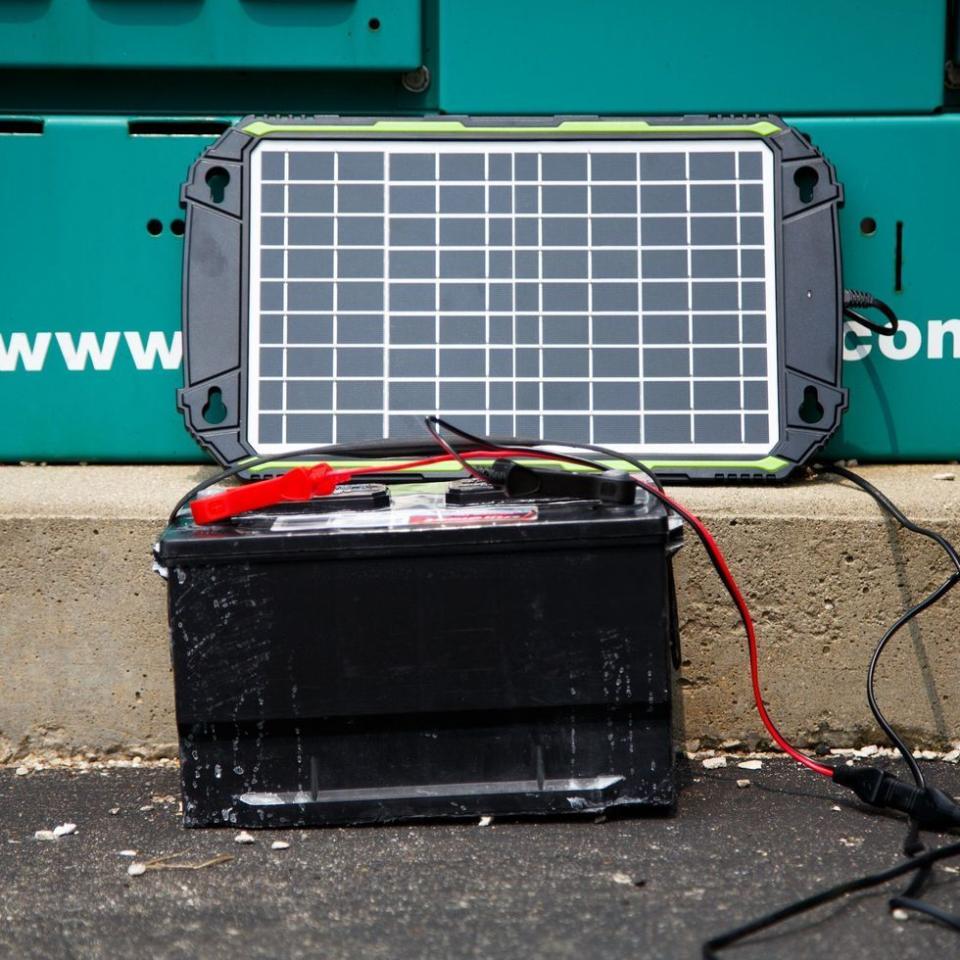A Step-By-Step Guide on How to Charge a Car Battery

"Hearst Magazines and Yahoo may earn commission or revenue on some items through these links."
This article was updated in November 2023 with new products and information.
You drove home last night and everything was fine with your vehicle, but this morning, you have a dead battery. You need to get your car going again—of course. But how? You could use a portable jump starter or, worst case, finagle a jump-start from a neighbor, friend, or relative. But there's an important step even after that: recharging your battery.
This is especially important when you only drive a short distance after jumping your vehicle—your alternator doesn't have enough time to recharge the battery fully. This is where a battery charger steps in. Most auto-parts stores carry chargers, and they're readily available through online retailers such as Amazon.
So how do you properly charge a car battery? Don't fret—it's super easy. We'll show you how to recharge it in five simple steps with accompanying video clips.
A word of caution—if this doesn't work, then there are larger issues at play, such as a bad battery, parasitic draw, or other electrical issues. If this happens, your best bet is to jump-start the vehicle, and take it down to your trusty local mechanic for a proper diagnosis.
What to Expect:
Estimated time: 5 minutes for setup, 1–6 hours for battery charging, overnight for a full recharge
Experience level: Beginner
If you can't find the battery terminals under the hood, checking the owner's manual will save a lot of time.
What You'll Need
Along with a battery charger, there are a few things you might need when tackling this job—these will do the trick.
Extension Cord (if needed)
Pocket Screwdriver for battery cover removal (if needed)
How to Recharge Your Battery: Step-By-Step
Step 1: Find your vehicle's battery and locate the positive and negative terminals.
Most cars have their battery under the hood. The positive terminal is marked with a "+," and the negative terminal is marked with a "-." Sometimes the terminals are protected by plastic covers that need to be flipped out of the way. Other vehicles have their batteries in the trunk. If you're struggling to find them, consult that handy owner's manual.
Step 2: Verify your battery charger is unplugged and turned off.
Before attaching the battery charger, it's important to verify no current is flowing through it before connecting to the terminals on your vehicle. Unplugging it prevents sparks—which can be dangerous if your battery is leaking. Read the instructions that come with the battery charger, as each charger operates a little differently.
Step 3: Attach the battery charger to your vehicle's battery terminals.
Attach the charger's red clamp to the battery's positive terminal and the black clamp to the negative terminal. Give the clamps a little wiggle to ensure that they have a good connection to the terminals. For the greatest safety, keep the charger as far away from the battery as the cables allow.
Step 4: Plug the charger in and turn it on.
Some chargers can identify the battery automatically, while others need to be inputted manually. Once that's figured out, simply select which charging amperage you want. As a rule of thumb, higher amperage = faster charge times, while lower amperage is slower, but more gentle on your vehicle's battery, possibly extending its life.
Other chargers work differently; they may not shut off automatically but rather have gauges that let you know when the battery is charged. Many battery chargers deliver two to six amps and can take at least several hours to recharge a dead car battery. Double-check the instructions that come with the charger to be sure you're operating it correctly.
Step 5: Disconnect everything once the battery is charged.
When the battery is fully charged, shut off the charger and unplug it. Then remove the cables, unhooking the negative (black) clamp first.
Our Recommended Car Battery Chargers
NOCO Genius 1
The NOCO Genius 1 employs a lower 1.0-amp setting to begin a slow, steady charge. It's designed to work with the gamut of battery options—regular lead-acid, AGM, and lithium. Navigating the mode selection button provided a satisfying tactile feel when cycling through options. NOCO seems focused on delivering an effective, user-friendly charger, and to that end, the company nailed it with the Genius 1.

NOCO Genius 1
amazon.com
$29.95
Gannon BurgettBattery Tender 3-Amp Battery Charger
For Battery Tender's 3.0-amp model, we struggled to find any flaws other than some users may find the LED lights a little dim. Otherwise, in terms of its operation, the Battery Tender uses a single button to toggle between 6- and 12-volt. Once a selection is made, you set it and forget it. It's that straightforward. We commend Battery Tender for adhering to the essentials, especially in a market where products can become overly complex.

Battery Tender 3-Amp Battery Charger
amazon.com
$69.95
Gannon BurgettSun Energise Solar Battery Charger & Maintainer
If your vehicle will be parked away from a conventional power source, consider harnessing the sun instead with the Sun Energise 10-watt solar panel. Designed to be used inside or outside your car, the Sun Energise features four suction cups for windshield application. Naturally, the prime limitation of Sun Energise is its reliance on sunlight. Because of this, we recommend using it as a reliable backup rather than your sole charging provider.

Sun Energise Solar Battery Charger & Maintainer
amazon.com
$59.97
Gannon BurgettFAQs
How long does it take to charge a car battery?
This really depends on the amount of amperage the battery charger will output. On the low end, most range from one to three amps (often called a trickle charge) and top out between eight to twelve amps. There are other battery chargers that output higher amperage, but that amount can overwhelm your vehicle's battery.
Selecting a trickle charge will typically take overnight to recharge your battery fully. Such low amperage is usually used for maintaining the battery, but it can also be used to recharge if you have enough time. Higher output amperage will usually charge your vehicle's battery in anywhere from one to six hours, depending on the state of charge.
How long does it take to charge a dead car battery?
Expect to let the charger take its sweet time with this. For a totally dead battery, your best bet is to let it charge overnight at low amperage to prevent any additional stress to the battery's cells. You can rush it, but the risk of causing long-term damage to the battery is much higher.
How do I charge a battery at home?
All you need is a battery charger and an outlet. Locate your vehicle's battery terminals, verify your charger is unplugged and off, attach the charger to the battery, plug it in and turn it on, set the correct settings, and you're good to go!
How do I charge a car battery without a charger?
Ideally, your vehicle is supposed to do this on its own thanks to a handy part called an alternator. Simply, the alternator is a magnetic coil that is powered by the vehicle's engine. It then generates current that gets routed back to the battery, recharging it as you drive. A faulty alternator is often the cause of a dead battery. In short, you can't really charge a car battery without a charger—that's the job of the alternator.
How to Tell If a Car Battery Is Dead
The terminology can be confusing, but a "dead" battery is typically just a battery with a low charge. Thanks to the robust engineering that goes into these magic boxes, a simple recharge might be all it needs. But how can you tell?
Now, there are a multitude of reasons your car won't start—but a dead battery is a good place to begin troubleshooting. If you hear a "tick-tick-tick"or your engine "chugs" slowly while attempting to start, these can be indicators of a low battery. Some vehicles will even illuminate a red battery light on your dash—which says there's an issue with the charging system.
If you jump-start a car and it starts, that's great—but it's important to figure out why you needed to jump-start it in the first place. Connecting it to a charger afterward is a good next step. From here, you can see if your battery takes or holds a charge. This can lead you to the next diagnostic phase, such as testing the alternator or checking for parasitic draw.
Another option is to swing by your trusty local mechanic for a battery test. This can give you an idea of the battery's condition and if you need to replace the battery. Remember, there's nothing wrong with having a professional check it out—it might cost more upfront, but it can save you from chasing around an electrical gremlin on a late Saturday night.
In the end, if your car doesn't start normally on its own, something is wrong. Just because it started when you jumped it, doesn't erase the fact that it needed to be jump-started. It's worth figuring out the problem—whether that be a low battery or something else—so you don't have to deal with it again.
You Might Also Like

 Yahoo Autos
Yahoo Autos 